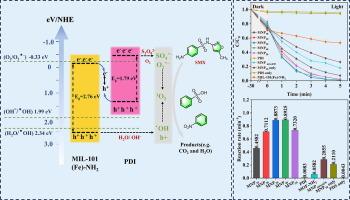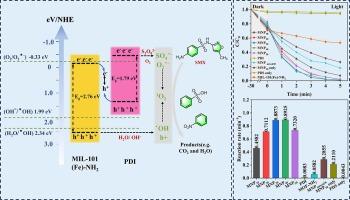Fast removal of sulfamethoxazole by MIL-101(Fe)–NH2/perylene diimide activated persulfate under visible light
IF 9
1区 工程技术
Q1 ENGINEERING, CHEMICAL
引用次数: 0
Abstract
Photocatalytically induced persulfate (PS) activation is considered a viable approach to counter the threat of resistance genes caused by the continuous accumulation of sulfamethoxazole (SMX) in the aqueous environment. In this study, the electrostatic interaction between MIL-101(Fe)–NH2 and perylene diimide (PDI) was exploited to fabricate composite catalysts (MNPx) with Z-scheme heterojunctions, which were applied to active peroxydisulfate (PDS) for SMX degradation under visible light. The most efficient MNPx/PDS/vis system recorded a 99.2 % reduction in SMX concentration, with an associated reaction rate of 0.8873 min−1. This performance was superior to the PDI/PDS/vis and MIL-101(Fe)–NH2/PDS/vis systems, being 106.9-fold and 15.2-fold more effective, respectively. The Z-scheme heterojunction of the photocatalyst accelerated electron transport, inhibited electron-hole recombination, and improved the efficiency of PDS activation; meanwhile, the substantial surface area of the MIL-101(Fe)–NH2 provided additional reaction sites, these features synergize to enable the rapid removal of SMX. The MNPx/PDS/vis system degraded SMX at a higher rate under acidic and neutral conditions. Besides, degradation pathways for SMX have been proposed, and the biotoxicity of SMX as well as the by-products gradually decreased as the degree of degradation deepens. This study presented a simple strategy for the Z-scheme heterojunction photocatalyst preparation and a reference for the disposal of sulfamethoxazole-containing wastewater.


MIL-101(Fe)-NH2/perylene diimide 活性过硫酸盐在可见光下快速去除磺胺甲噁唑
光催化诱导过硫酸盐(PS)活化被认为是应对水环境中磺胺甲噁唑(SMX)持续积累所导致的抗性基因威胁的一种可行方法。本研究利用 MIL-101(Fe)-NH2 和过二亚胺(PDI)之间的静电作用制造了具有 Z 型异质结的复合催化剂(MNPx),并将其用于活性过二硫酸盐(PDS),在可见光下降解 SMX。最高效的 MNPx/PDS/vis 系统可将 SMX 浓度降低 99.2%,相关反应速率为 0.8873 分钟-1。这一性能优于 PDI/PDS/vis 和 MIL-101(Fe)-NH2/PDS/vis 系统,分别提高了 106.9 倍和 15.2 倍。光催化剂的 Z 型异质结加速了电子传输,抑制了电子-空穴重组,提高了 PDS 的活化效率;同时,MIL-101(Fe)-NH2 巨大的比表面积提供了额外的反应位点,这些特征协同作用,使 SMX 得以快速去除。在酸性和中性条件下,MNPx/PDS/vis 系统对 SMX 的降解率更高。此外,人们还提出了 SMX 的降解途径,随着降解程度的加深,SMX 的生物毒性和副产物也逐渐降低。本研究提出了一种简单的 Z 型异质结光催化剂制备策略,为含磺胺甲噁唑废水的处理提供了参考。
本文章由计算机程序翻译,如有差异,请以英文原文为准。
求助全文
约1分钟内获得全文
求助全文
来源期刊

Separation and Purification Technology
工程技术-工程:化工
CiteScore
14.00
自引率
12.80%
发文量
2347
审稿时长
43 days
期刊介绍:
Separation and Purification Technology is a premier journal committed to sharing innovative methods for separation and purification in chemical and environmental engineering, encompassing both homogeneous solutions and heterogeneous mixtures. Our scope includes the separation and/or purification of liquids, vapors, and gases, as well as carbon capture and separation techniques. However, it's important to note that methods solely intended for analytical purposes are not within the scope of the journal. Additionally, disciplines such as soil science, polymer science, and metallurgy fall outside the purview of Separation and Purification Technology. Join us in advancing the field of separation and purification methods for sustainable solutions in chemical and environmental engineering.
 求助内容:
求助内容: 应助结果提醒方式:
应助结果提醒方式:


